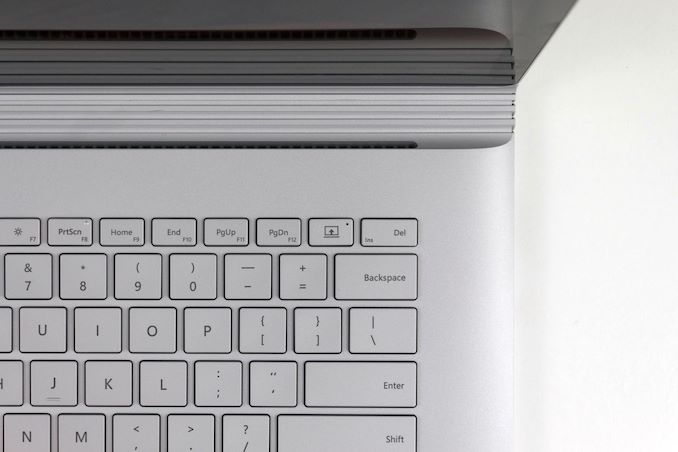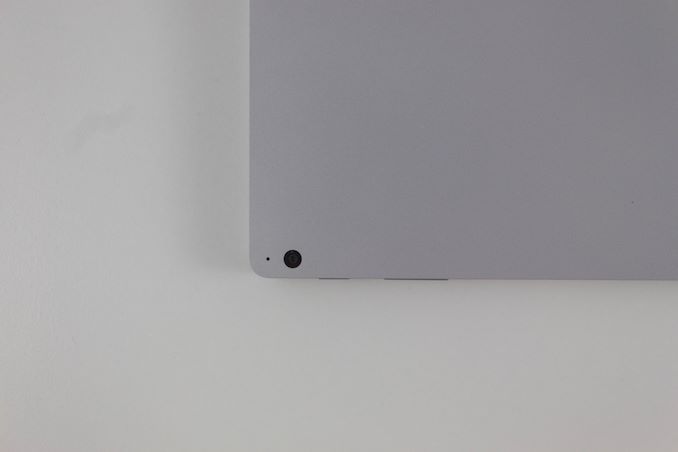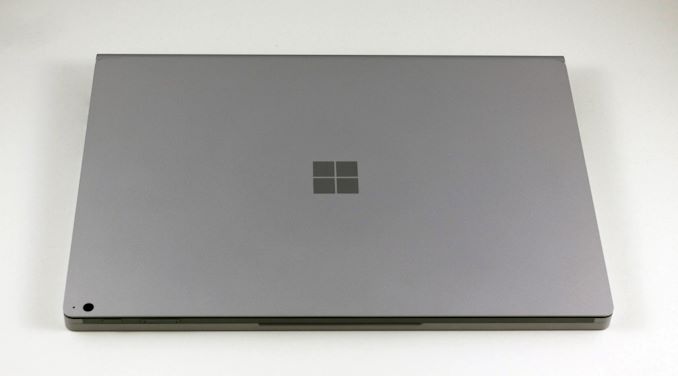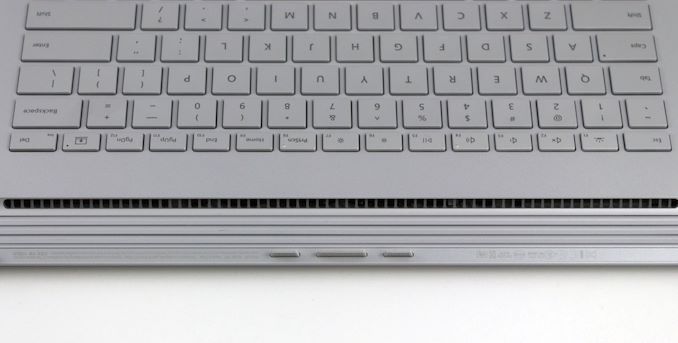The Microsoft Surface Book 3 (15-Inch) Review: A Refreshing Dip Into Ice Lake
by Brett Howse on June 3, 2020 9:00 AM ESTFinal Words
The Surface Book 3 delivers a solid refresh to Microsoft's detachable laptop family, offering more of almost everything. There is more performance thanks to the new Core i7-1065G7 and GeForce GTX 1660 Ti. There is more RAM thanks to the switch to LPDDR4X. The new 10 nm processor provides better battery life. The Wi-Fi is much improved thanks to the new Intel AX201 Wi-Fi 6 adapter. Even the USB ports got an upgrade to USB 3.2 Gen 2, while the Surface Connect port now offers the same 3.2 Gen 2 speeds along with DisplayPort 1.4 for dual-UHD external monitor support. If you loved the idea of the Surface Book 2 but thought it was a bit long in the tooth or otherwise underpowered, the new Surface Book 3 delivers all of the upgrades needed to keep it a proper current generation notebook.
Surface devices have always offered a great build quality, and the Surface Book 3 continues that legacy with its magnesium alloy chassis. Microsoft has improved the undocking mechanism to make it faster, and improvements to DirectX 12 mean that the system is finally able to automatically migrate active workloads from the discrete GPU to the integrated one when detaching, at least as long as the active application supports this.
The Surface Book 3, like the Surface Book 2, offers one of the best typing experiences on any notebook, and couples it with one of the best trackpads around. The display is still identical to the outgoing model, but that display is also one of the best available on a notebook, so it is hard to fault them for keeping it.
Microsoft still includes 1080p video recording support, with a 5 MP front facing camera and 8 MP rear facing camera, and coupled with the dual far-field microphones makes the Surface Book 3 an ideal, if somewhat overpowered, video conferencing device.
There is no denying that the upgrades have worked well. If there was a complaint, it would be that this is now the third generation of more or less the same design, and while a design that is still impressive, it also is showing its age. The large display bezels, while partially required due to the convertible nature of the Surface Book, stand out in a premium device in 2020. The lack of Thunderbolt 3 support is also an increasingly glaring omission when all of their competitors offer it. It took Microsoft a long time to adopt USB Type-C for reasons only they seem to understand, and while it is nice to finally have that, a universal docking solution over Thunderbolt 3 would serve them well.
The Surface Book 3 still does fulfill its role though as a very powerful laptop, built with premium materials, and offering some unique features. The upgrades for 2020 were necessary to keep the design relevant, even if is relatively unchanged on the outside. The new configuration options, especially the ability to purchase it with 32 GB of RAM, opens up the device to those who need a lot of RAM for their workflows, and being able to purchase it with Quadro RTX also opens the door to some new mobile workstation use cases. Surface Book is never going to be the sales leader in the Surface lineup, mostly due to the price, but there is no denying that it is still one of the best notebooks on the market.














125 Comments
View All Comments
Xex360 - Wednesday, June 3, 2020 - link
It's very disappointing that they didn't use Ryzen APUs.But anyway it's very slow to do any real work on it, plus in their wisdom (or absence of thereof) didn't include a proper keyboard with keypad.
thesavvymage - Wednesday, June 3, 2020 - link
numpad laptops are a thing of the past. Anybody who NEEDS one probably works at a desk with a dock and can use a USB one. They take up a huge amount of keyboard space and rarely get used.drothgery - Wednesday, June 3, 2020 - link
This is going to be a comment on every premium laptop review until either Intel gets an 8-core U-series part out on 10 nm or smaller or Ryzen starts showing up in premium notebooks, isn't it?Anyway, no one's using Ryzen in premium laptops right now. Ryzen 4xxx is the first AMD notebook chip worthy of being in a premium laptop, erm, ever (even when AMD was stacking up quite nicely vs Intel on the desktop, low power parts were another story), and premium laptops have a longer lead time than simpler value and gaming designs. Come back again next fall, especially if Intel doesn't show plans for an 8-core/15 Watt Tiger Lake.
alufan - Thursday, June 4, 2020 - link
Funny that despite the AMD being a better product Dell etc still put intel into the best chassis with the best components wonder why that is...rebates perhapsDeicidium369 - Thursday, June 4, 2020 - link
Most likely in response to customers... I know it's hard to believe - but the world sees AMD as a bargain bin brand - right or wrong, that is the perception.Spunjji - Thursday, June 4, 2020 - link
"Brands have no power to change customer perceptions of value through the products they sell" is a bold claim.Retycint - Thursday, June 4, 2020 - link
It's not an instant transition, especially for the average consumer that doesn't follow tech news. Ryzen and AMD still has some catching up to do with regards to brand equity.Spunjji - Thursday, June 4, 2020 - link
On that front I agree completely - but if that were the only obstacle, you'd expect to see Dell beginning the transition. Asus have with the G14.It's a fairly simple equation - you draw on your existing brand credibility and add a new option. You advertise its strengths. Consumers who don't follow tech news don't know the difference between AMD and Intel, but they know what "same design, more cores, faster performance, less heat" means.
Deicidium369 - Friday, June 5, 2020 - link
Asus itself is not perceived as a premium brand - I have never owned an Asus laptop and avoid their motherboards and video cards like the plague - but have had several Asus monitors over the years - they had the first true GSync monitor way back when.ExarKun333 - Thursday, June 4, 2020 - link
This. AMD made huge inroads on this from 2000-2005 and really positioned themselves as the market leader. As a big user of this site and AT's BB then, we all jumped on much earlier but that was more from enthusiasts. Then Intel's Core arrived in 2006. And Intel swiftly started shifting back the performance brand, image and raw performance leads. 5 Years ago, AMD laptop marketshare was barely existent. As someone waiting to buy a gaming laptop right now, I really want a Ryzen-powered laptop with a Nvidia GPU, which isn't available above a 1660/2060. Ill bite when it is. :)